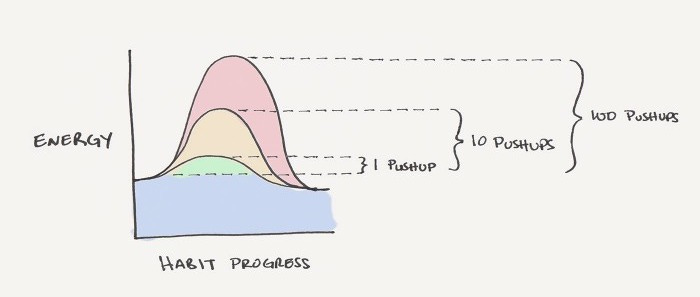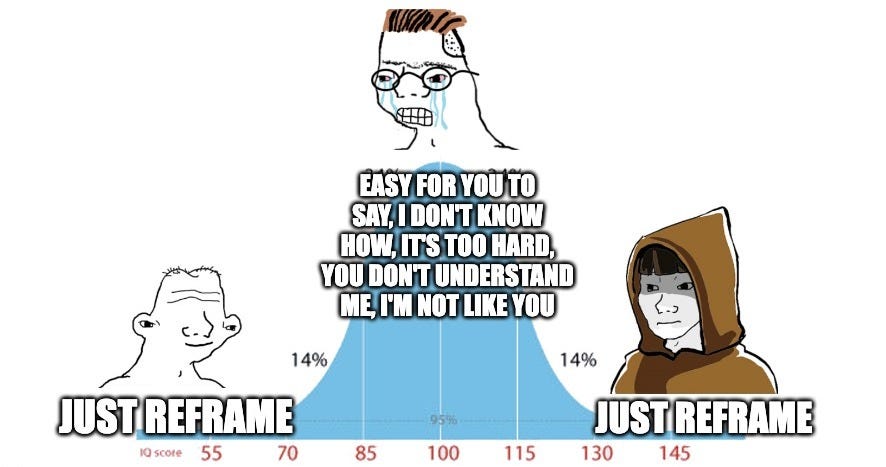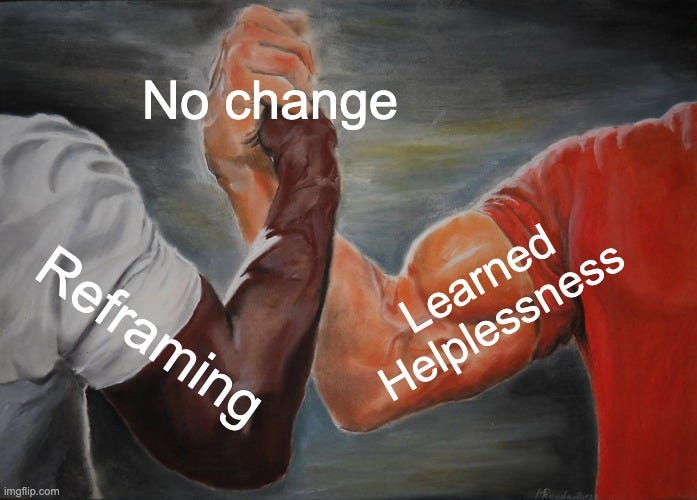Reframing
My stab at operationalizing a nebulous topic
Imagine you’re catching up with a friend over brunch. You were recently fired and are now chatting over crunchy hash browns, slightly too greasy sausages, and coffee with sugar (because who doesn’t like to be caffeinated?).
When it’s your turn to talk about life updates, you spill your angst across the table as your friend nods along and offers the usual but very invited condolences.
After all the usual things are said, your friend follows up: “why don’t you see it like this…”
Your friend just gave you advice to reframe. Now what?
What Exactly is Reframing?
You most definetely have reframed things before, whether you identified it or not.
Regardless, what exactly is reframing?
A quick Google search defines reframing as “changing the way you think about and experience a situation, event, or idea, often to view it in a more positive or constructive light.”
I like to make an analogy from an example by Daniel Kahneman when describing “reference-dependence”.
Given the two inner grey squares in the figure below, which one looks lighter?

It’s the left one right?
Wrong.
The two inner squares are actually the same shade. The brightness of the surrounding framing squares makes the inner squares appear lighter or darker.
To complete the analogy, the inner square is the external circumstance- an unfortunate event- to be reframed. The outer square is our own reframing built around the external circumstance to change how it is perceived.
We have the agency to set the brightness of the frame and change how we perceive the set of available facts. Though the facts may be objectively grim, it is the subjective interpretation of the facts that impact well being.
What is the Purpose of Reframing?
Given a set of negative circumstances, I am a very strong believer of agency to influence long term outcomes.
You may have just gotten fired, dumped, or injured. That sucks and we can’t go back in time to prevent that from happening.
You deserve sympathy and that cannot be said more.
But at the end of the day, what are you going to do about it?
Beginning to enact a change from present reality is already pretty difficult: there is an activation energy required for initial action. This is even more difficult when there is tragedy involved as well- it’s much easier to give into victimhood and immediately give up when things aren’t going your way.

There’s two ways to reach this activation energy threshold. You could decrease the activation energy required to make the initial commitment easy or you could drastically increase energy to surpass the threshold.
Reframing helps with both.
Here’s an example.
A year ago, I worked at a trading firm. Despite the culture, team, and my project all being great and significant, I was just not interested in the work I was doing. With big bonuses in the horizon and being in a position to lead a sub-team in a year or two’s time, I was effectively in Golden Handcuffs.
To decrease activation energy, I reframed monetary compensation from being an absolute number to being relative to my lifestyle.
While I had a great income, my lifestyle still mirrored mine from university. I ate the same rice / chicken breast / frozen veggie meal for most dinners, studied, read, and hung out in my downtime, and did one big vacation each year.
My income did not change my lifestyle and I was pretty happy. If my income were to increase, my lifestyle and happiness would likely not change. Thus, the benefits of staying in the Golden Handcuffs were not as enticing anymore.
To compound this, I reframed Golden Handcuffs in a longer time horizon and pictured myself in a knife fight with regret. Instead of letting regret stab me in the future as I look into the past and I wish I did what I loved, I chose to stab myself and twist the knife to embrace the pain, pushing myself to pursue change.
Under these two reframes, I surpassed the activation energy to start recruiting, which landed me in New York pursuing more interesting pastures.
Why It’s Brushed Off So Much
Easy for you to say… You don’t understand me… I’m not like you… Must be nice…
Reframing suffers from the common tropes of advice being easier said than done. “Break up with him,” “Quit your job” and “Think about it this way” take no effort to say, but all the effort to do.
Unlike the former two pieces of advice, the process of reframing is not obvious. To break up with someone, you set up a time to talk. To quit, you send a resignation email to HR. What does reframing actually look like?
While things like therapy and journaling may generally be helpful, I don’t believe there is a prescription that works for everyone. Only by stumbling in the dark can the best personalized method be found.
This ambiguity is enhanced by contrasting private processes and public outcomes.
You probably know someone who has successfully reframed a horrific event, but you’re unsure about how they actually did it. You just see that final reframe.
With additional charged emotions clouding judgment, reframing comes off as some voodoo magic only mastered by ascended zen monks who meditate for 25 hours a day.
It seems unattainable for mere mortals.
What Reframing Actually Looks Like
While I’m not sure how others reframe, I know very well how I do so.
Let’s revisit the grey squares again.
To get the color of the outside square to my reframe, I paint layers over the initial color established by pessimism and fear. One layer of paint is represented by one iteration of thinking through a reframe, which is the logical thought thread for why my reframe is correct and the reasoning for how to arrive at such conclusion.
At the beginning, the paint job looks quite discouraging. Despite all the inner dialogue put into the initial layers of paint, the color underneath still shows and the inner square looks dark. I am still not fully convinced about my own reframe and the sadness from pessimistic outlooks feels very visceral.
However, no matter my emotions, the only way to fully block out the color underneath is more layers of paint.
So, I paint.
Over hundreds of layers (I tend to be stubborn), the negative frame becomes hidden, completely covered by the reframe layers I painstakingly applied.
If you were to catch me after this is done, the conversation would be very straightforward. All the pain and iterative thoughts have been abstracted away into a single matter of fact “I see the situation in this way now.” There would be no tears and little worry- all those pessimistic emotions have been reduced.
This may take a long time depending what the situation is. And time itself eases a lot of pain. To quicken the pace of reframing, I find obsessively iterating through the reframe works tremendously.
This means I commit to reframing when I’m doing the dishes, walking to the subway, folding the laundry- my brain consciously works to put the reframed view into my subconscious in the least amount of days possible. I may temporarily lose live-in-the-moment mindfulness, but I reach an optimistic state to enact action much faster.
Reframing as a Tool
In the same vein of being potent for optimistic viewpoints and positive action, reframing can also be used in a pessimistic manner. Reframing is merely a tool. A hammer can be used to put nails into wood while building a house; it can also be used to bash someone’s head in.
In my opinion, reframing is most dangerous when you use it to validate learned helplessness: this is just how the world works and nothing can be done to change that. You then begin to convince yourself that you actually are satisfied with the current situation all along.
Let’s take the example I gave earlier.
Given my Golden Handcuff job, I could have reframed the good pay and lack of interest as validation that I was never meant to do something I loved. Since so many people work for a paycheck, why should I look for anything different?
Furthermore, having a good manager, team, and project are many steps above “just working for a paycheck.” This is much better than what many others have. Why should I not just settle and let this be my life?
Instead of aggressively recruiting, I could have just convinced myself to not do anything different and just stick in it for the long term (which in itself is an active decision being made and action pursued).
This is an easy hole to fall into.
Since real change involves uncomfortable internal dialogue, there is a high activation energy to begin anything. It is much easier to do nothing and convince yourself that you are ok with that (or you are actually making progress and "figuring it out”).
You could give a pretty convincing argument too- you won’t sound insane if you shared the reframing end result “I am so happy with life” and all its associated justifications over brunch.
Using Reframing as a Skill
Since reframing is a personalized tool, I see the ability to reframe as a skill that can be improved as it is applied more frequently.
Reframing isn’t complex. It’s just difficult, especially with emotions and allure to give into what’s comfortable.
That doesn’t mean you shouldn’t try to get better at it though.
Getting better at reframing could be like using thicker paint- less layers are required.
The pace of applying each layer can also quicken- the amount of days between the situation occurring and responding action is reduced.
Furthermore, the initial outer frame color may not be as horrendous when beginning to paint- a instinctual tendency towards positive viewpoints.
Funnily enough, I start reframing bad situations by casting it as an opportunity to practice reframing. The worse the situation is, the better: I get to paint over a more ugly color and pursue action, which gives me the confidence to force my will in the future.
Ok. Now What?
Now you have some context on reframing, what are you going to say when your friend asks you if you thought about it in a certain way?
Don’t worry- you’re getting plenty of sympathy and going to get more of it from the many other friends you can grab brunch with.
The question is: what are you going to do?
How are you going to wield the tool of reframing?
Are you going to nail your house together or will you use it to bash your own head in?




